
The foxglove pug is a moth of the family Geometridae found in Europe. It was described by the English entomologist James Francis Stephens in 1831.

The scalloped oak is a moth of the family Geometridae. The species was first described by Carl Linnaeus in his 1758 10th edition of Systema Naturae.

The feathered thorn is a moth of the family Geometridae. It was first described by Carl Linnaeus in 1761.

Angerona is a monotypic moth genus in the family Geometridae erected by Philogène Auguste Joseph Duponchel in 1829. Its only species, Angerona prunaria, the orange moth, was first described by Carl Linnaeus in his 1758 10th edition of Systema Naturae.
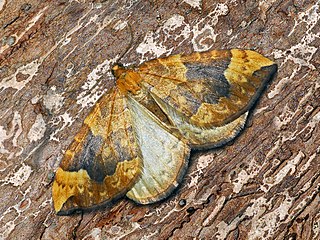
Eulithis populata, the northern spinach, is a moth of the genus Eulithis in the family Geometridae.

Camptogramma bilineata, the yellow shell, is a colourful moth of the family Geometridae. The species was first described by Carl Linnaeus in his 1758 10th edition of Systema Naturae. It can be found in Europe and east across the Palearctic to the Altai Mountains.

Ennomos alniaria, the canary-shouldered thorn, is a moth of the family Geometridae. The species was first described by Carl Linnaeus in his 1758 10th edition of Systema Naturae. It can be found in Europe in a wide variety of biotopes where there are deciduous trees, perhaps mostly in deciduous forests and gardens.
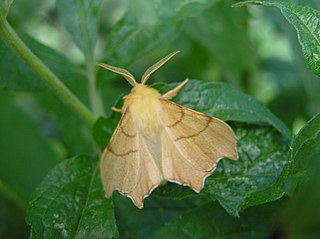
Ennomos erosaria, the September thorn, is a moth of the family Geometridae. The species can be found in the Palearctic realm in western Europe and from central Scandinavia. Its range extends to the northern Mediterranean and east to the Caucasus and Russia. It is widespread in mixed and deciduous forests in Europe. The south eastern occurrence reaches Turkey and the Caucasus. The main habitat is dry deciduous forests and parks. In the Southern Alps, the species rises to an altitude of about 1600 metres.
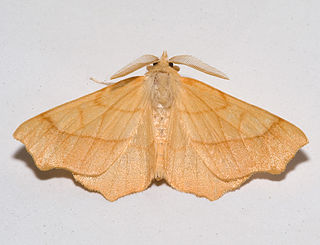
Ennomos quercinaria, the August thorn, is a moth of the family Geometridae. The species can be found in Europe. It was first described by Johann Siegfried Hufnagel in 1767.

Hylaea fasciaria, the barred red, is a species of moth in the family Geometridae. The species can be found in central and northern Europe, the Urals, Caucasus, Altai and eastern Siberia.
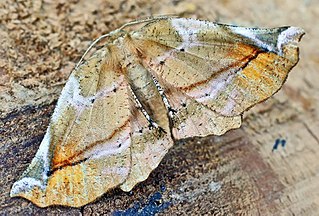
Apeira syringaria, the lilac beauty, is a moth of the family Geometridae. It is found throughout Europe and east across the Palearctic to the Russian Far East and Japan.

Rhodometra sacraria, the vestal, is a moth of the family Geometridae. The species was first described by Carl Linnaeus in his 1767 12th edition of Systema Naturae.

Idaea subsericeata, the satin wave, is a moth of the family Geometridae. The species was first described by Adrian Hardy Haworth in 1809. It is found from central and southern Europe, North Africa, Asia Minor to Transcaspia.

Aethalura punctulata, the grey birch, is a moth of the family Geometridae. The species is found in Europe and then east, as far as western Siberia and the Caucasus.This species prefers sparse alder-ash-floodplain forests on moist to wet locations. Although it is only locally distributed in Central Europe, it is usually common in these biotopes. It occurs from the plains to the middle mountain regions. In the Alps it rises up to 1600 m.

Ennomos fuscantaria, the dusky thorn, is a moth of the family Geometridae. The species can be found in the western part of the Palearctic realm in western Europe and from central Scandinavia its range extends to the northern Mediterranean and east to Russia.

Anticlea derivata, the streamer, is a moth of the family Geometridae. The species was first described by Michael Denis and Ignaz Schiffermüller in 1775. It is found in Europe, North Africa and across the Palearctic up to the Altai Mountains.It prefers to live on sunny slopes, hedge rows, bushy places as well as in gardens and parks.

Hydrelia sylvata, the waved carpet, is a moth of the family Geometridae. It is found throughout the temperate parts of the Palearctic realm.
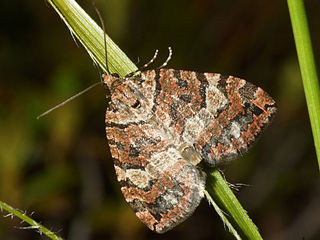
Hydriomena furcata, the July highflyer, is a moth of the family Geometridae. The species was first described by Carl Peter Thunberg in 1784. It is found in the Holarctic ecozone.

Agriopis aurantiaria, the scarce umber, is a moth of the family Geometridae. It was first described by Jacob Hübner in 1799 and it is found throughout Europe from Spain through Central Europe to Russia. In the south it can be found from the western Mediterranean to the Black Sea and the Caucasus. Its northern distribution reaches as far as central Fennoscandia. The species can be found in many different places, including deciduous forests, orchards, gardens as well as parks and settlement areas.

Aspitates gilvaria, the straw belle, is a moth of the family Geometridae. The species was first described by Michael Denis and Ignaz Schiffermüller in 1775. It is found from Europe to the eastern part of the Palearctic realm. The main habitats are warm slopes, heathlands, fields and abandoned quarries. In the mountains, the species rises to heights of 1000 meters. Adults are on wing from July to August.




















